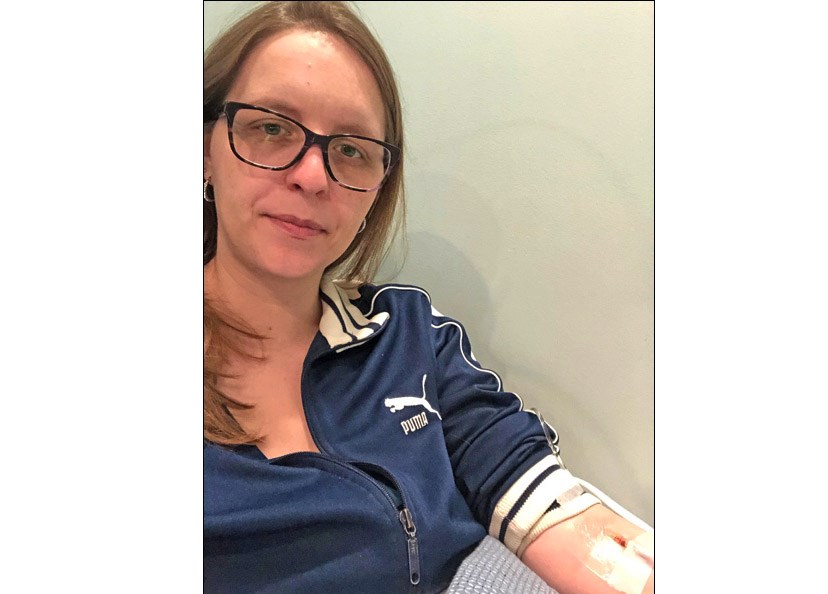Life hasn’t been easy for Jenna Sittler, not in the least because those who are supposed to help, medical professionals, haven’t helped much.
Sittler has experienced symptoms including chronic pain, exhaustion, stomach issues and sinus issues. Symptoms began late in high school. Now she’s 32.
“We’re talking a lot of years of a lot of pain,” Sittler’s mother Janet told the News-Optimist.
A letter from a neurologist described Jenna as quite disabled and stiff in the morning. She has used a wheelchair if leaving the house for more than 10 minutes. She has also experienced depression.
Determining a diagnosis has been challenging. Sittler has seen a general practice doctor, neurologist, rheumatologist, gastrointestinal specialist, ear nose and throat specialist and a psychiatrist.
She has tried multiple therapies over the years, and found a number of drugs and treatments to be ineffective.
Her pain has migrated, and some medical professionals have suggested it is fibromyalgia.
“I must admit that her level of disability is quite extreme for a diagnosis of fibromyalgia and depression,” the neurologist wrote, “though in the end these diagnoses may well be correct.”
After researching and talking to others, Janet thinks her daughter has been misdiagnosed. The real diagnosis, Janet believes, is chronic Lyme disease.
Lyme disease is a bacteria transmitted by infected ticks. According to Health Canada, most humans are infected by the bite of immature ticks called nymphs, which are about the size of poppy seeds, and which can be difficult to detect. A Lyme disease rash is shaped like a bullseye.
Lyme disease is usually cured by antibiotics if detected and treated early on. According to the Mayo Clinic, courses of oral antibiotics can last from 10 to 14, or 14 to 21 days. Intravenous antibiotics can also be used, for around 14 to 28 days.
For Jenna, Lyme disease wasn’t detected around the time symptoms began and much of the medical community doesn’t recognize Lyme disease as having a “chronic” manifestation.
Signs and symptoms of Lyme disease are often found in other conditions, according to Mayo Clinic, so diagnosis can be difficult.
When her daughter was diagnosed with fibromyalgia, Sittler was unconvinced.
“There’s too much going on here,” Sittler said, referring to a meeting with a general practitioner. “[I said] I want a Lyme test.”
The doctor didn’t think it was necessary, but Sittler insisted. A test came out negative.
The standard test used in Canada for Lyme disease is two-tiered, and doesn’t actually measure the Lyme disease infection but the body’s response to the infection.
“If you come up negative on the first test, they don’t test you for the second test,” Sittler said. Her daughter sought a second test anyway in Canada, and it also came up negative.
The women sought out the help of Dr. Eric Chan, a naturopathic doctor in British Columbia. He sent test results to labs in the United States and Germany, Sittler said, and they came up positive.
According to the neurologist, those results could be false positives.
According to Dr. Chan, treatment can be more complex than a Lyme diagnosis. On his website he writes "drug therapy for chronic lyme typically involves different types and combinations of antibiotics when treating a resistant, or chronic case.”
One hesitancy of the medical community is that administering antibiotics for long periods of time can have risks, including infections.
Meanwhile, treatment is expensive.
Sitter wants a clinical diagnosis of Lyme disease in Saskatchewan as it could also help pay for treatment.
A number of patients with similar symptoms have come forward with similar stories as Jenna. A chronic Lyme disease community has emerged.
Health Canada recognizes that some patients have persistent symptoms following treatment.
However, “research continues into the causes and methods of treatment,” according to Public Health Canada, and the established medical community wants more evidence.
A step in the right direction for the chronic Lyme disease community is Public Health Canada listing ILADS on a webpage about Lyme disease.
One guideline is “ILADS recommends antibiotic retreatment when a chronic Lyme infection is judged to be a possible cause of the ongoing manifestations and the patient has an impaired quality of life.”
Janet said Jenna has questioned if it’ll make a difference, and her daughter didn’t know if “it’s good or bad” if general practitioners believe her.
Talking to politicians, Janet said, has been a roundabout experience, although the Saskatchewan Health Authority told her they would look into possibly clinically diagnosing Jenna.
The government of Saskatchewan has also upped public awareness of Lyme disease and to look out for ticks. May is Lyme disease awareness month.
The symptoms and the uncertainty have taken a toll on the family
“I wouldn’t wish this on anyone,” Janet said. “It’s been crazy and it’s been a lot of years.”
Correction: A earlier version of this article referred to Jenna Sittler as Jenna Fairhead. The name has since been changed.
An earlier version of this article also stated Dr. Chan sent results of the second test to U.S. and Germany. The article has since been changed to say "test results" instead.



